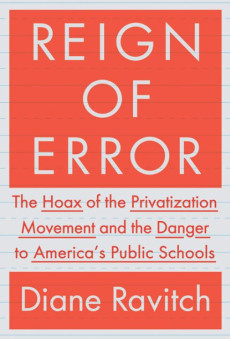
Reign of Error: The Hoax of the Privatization Movement and the Danger to America’s Public Schools
Diane Ravitch
416 pages, Knopf, 2013
Consider a few stories from a recent week: Friends of mine pulled their seven-year-old daughter out of public school after two weeks of constant tears (mostly the child’s, sometimes the parents’) that were a consequence of daily testing. A kindergarten teacher I know had her block corner, her dress-up corner, and all of her toys removed from her classroom because they were no longer part of her school’s prescribed curriculum. And a group of teachers in training at my university returned from field placements and described watching veteran teachers discard their elaborate, creative lesson plans because an evaluator from a standardized curriculum publisher was coming to their school.
None of these anecdotes would surprise Diane Ravitch. In her new book, Reign of Error, she brilliantly describes each of these distortions of the relationships that connect teachers, students, parents, and teacher educators. Her own history as a professional educator adds weight to her critique: She received appointments to public office from Presidents George H.W. Bush and Bill Clinton, and she was a member of the National Assessment Governing Board. She was an early and vocal supporter of the charter school movement and the legislation known as No Child Left Behind—both of which she now criticizes strongly. Her involvement with the other side of the education debate and her “turnaround” story enable her to speak with insider knowledge and from a broad perspective.
Ravitch issues a powerful and alarming message about the fate of public education in the United States. “This essential institution, responsible for producing a democratic citizenry and tasked with providing equality of educational opportunity, is at risk,” she writes. Corporate “reformers” (one might say “deformers”) who profit enormously from the creation of privatized education are depriving vast numbers of students of a rich, full education. The very essence of our democracy—our understanding of who we are and how we provide for our children—is in jeopardy.
How did we get here? It’s important to examine the narratives—the stories we hear again and again, the headlines that scream at us—that have shaped our understanding and allowed us to accept policies that result in profit for a few and lost opportunity for many. If (as we’re told) our schools are failing, teachers are to blame, competition is the answer, and poverty doesn’t matter, then all we have to do is get rid of “bad teachers,” apply “market discipline” to our schools, and “raise standards.” We don’t have to think about the impact that poverty and racial segregation have on students and families.
In chapter after chapter, Ravitch skewers each of those claims about the supposed failure of public education and then describes the corresponding reality. She shows that schools aren’t failing, that the achievement gap hasn’t gotten worse, that high school graduation rates are at an all-time high, that test scores are not the best tool for identifying good teachers, and that charter schools on average are no more innovative or successful than traditional public schools.
Ravitch presents compelling evidence that the two major causes of the crisis in public education are poverty and racial segregation. Many educational policymakers and many founders of for-profit schools tell us that poverty doesn’t matter. But children who lack access to decent food, housing, health care, and other resources come to school at a serious disadvantage. How could poverty not matter? All the other narratives of school “reform” function as distractions that disengage us from the real work—the hard work—of changing our educational system and our society. Schools must change, but they cannot fix the structural problems caused by inequality and injustice.
Ravitch proposes 11 solutions that will help to repair and restore public education. Some of them are school-based, and many people will find them relatively uncontroversial: providing early-childhood education; ensuring a full, rich curriculum; reducing class sizes; eliminating high-stakes testing; preserving democratic control over public schools; and treating teachers, principals, and superintendents as professional educators. But these more-palatable solutions leave unchanged the core problems that Ravitch says we must address. So she proposes additional solutions: providing adequate prenatal care, offering wrap-around medical and social services, and confronting racial segregation and poverty.
A deeper, more honest conversation about this topic would focus on whether we actually want public education to work. Reducing structural inequality would require those with power and privilege to give some of it up. And there’s the rub. Many people who espouse “quality education for all” benefit from our stratified, segregated, inequitable educational system, and they are unlikely to support real social change.
Missing from this volume but essential to our understanding of the issue are the voices of real teachers, real parents, real students. All across the country—from ongoing protests in Madison, Wis., to parent groups that opt out of standardized testing, to the creation of the Bad Ass Teachers’ Association—people are rising up and saying “No” to the destruction of all that they value about schools. Along with the important story that Ravitch tells, we need to hear the stories of those who are finding ways to push for equity-based education.

